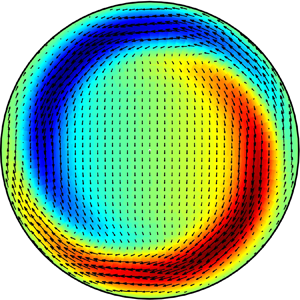Article contents
Linear stability of slip pipe flow
Published online by Cambridge University Press: 15 January 2021
Abstract

We investigated the linear stability of pipe flow with anisotropic slip length at the wall by considering streamwise and azimuthal slip separately as the limiting cases. Our numerical analysis shows that streamwise slip renders the flow less stable but does not cause instability. The exponential decay rate of the least stable mode appears to be  $\propto Re^{-1}$ when the Reynolds number is sufficiently large. Azimuthal slip can cause linear instability if the slip length is sufficiently large. The critical Reynolds number can be reduced to a few hundred given large slip lengths. In addition to numerical calculations, we present a proof of the linear stability of the flow to three-dimensional yet streamwise-independent disturbances for arbitrary Reynolds number and slip length, as an alternative to the usual energy analysis. Meanwhile we derived analytical solutions to the eigenvalue and eigenvector, and explained the structure of the spectrum and the dependence of the leading eigenvalue on the slip length. The scaling of the exponential decay rate of streamwise independent modes is shown to be rigorously
$\propto Re^{-1}$ when the Reynolds number is sufficiently large. Azimuthal slip can cause linear instability if the slip length is sufficiently large. The critical Reynolds number can be reduced to a few hundred given large slip lengths. In addition to numerical calculations, we present a proof of the linear stability of the flow to three-dimensional yet streamwise-independent disturbances for arbitrary Reynolds number and slip length, as an alternative to the usual energy analysis. Meanwhile we derived analytical solutions to the eigenvalue and eigenvector, and explained the structure of the spectrum and the dependence of the leading eigenvalue on the slip length. The scaling of the exponential decay rate of streamwise independent modes is shown to be rigorously  $\propto Re^{-1}$. Our non-modal analysis shows that overall streamwise slip reduces the non-modal growth, and azimuthal slip has the opposite effect. Nevertheless, both slip cases still give the
$\propto Re^{-1}$. Our non-modal analysis shows that overall streamwise slip reduces the non-modal growth, and azimuthal slip has the opposite effect. Nevertheless, both slip cases still give the  $Re^2$-scaling of the maximum non-modal growth and the most amplified disturbances are still streamwise rolls, which are qualitatively the same as in the no-slip case.
$Re^2$-scaling of the maximum non-modal growth and the most amplified disturbances are still streamwise rolls, which are qualitatively the same as in the no-slip case.
JFM classification
- Type
- JFM Papers
- Information
- Copyright
- © The Author(s), 2021. Published by Cambridge University Press
References
REFERENCES
- 6
- Cited by





